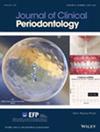3D Method for the Volumetric Evaluation and Visualisation of Dental Biofilms: A Proof-of-Principle Study.
IF 6.8
1区 医学
Q1 DENTISTRY, ORAL SURGERY & MEDICINE
引用次数: 0
Abstract
BACKGROUND AND OBJECTIVE Traditional and planimetric plaque indices rely on plaque-disclosing agents and cannot quantify three-dimensional (3D) structures of dental biofilms. We introduce a novel computer-assisted method for evaluating and visualising plaque volume using intraoral scans (IOSs). MATERIALS AND METHODS This was a 4-day, non-brushing, plaque-regrowth study (n = 15). All plaque was removed at baseline (T0). IOSs at T0 and after 4 days (T4) were used for volumetric plaque assessment in six steps: model acquisition, model superimposition, computer-aided determination of tooth-surface margins, tooth-surface superimposition, visualisation and volumetric evaluation of biofilms. Plaque formation at T4 was additionally assessed with the Turesky Modification of the Quigley-Hein Plaque Index (TMQHPlI). We used Pearson's correlation coefficients and multilevel models to investigate the relationships between TMQHPlI, volumetric plaque index (VPI) and the adjusted volumetric plaque index (AVPI, plaque volume/area). RESULTS VPI and AVPI positively correlated with the TMQHPlI, showing higher variability at lower TMQHPlI scores. VPI had a lower threshold for plaque detection and higher sensitivity than the TMQHPlI. VPI and TMQHPlI were highest on vestibular, maxillary and molar surfaces. CONCLUSION VPI quantifies biofilm deposits, is a more precise measure for plaque detection than the TMQHPlI and can be visualised using colour-coded maps displaying areas of equal plaque thickness.牙科生物膜体积评估和可视化的3D方法:一项原理验证研究。
背景与目的传统的面形牙菌斑指数依赖于牙菌斑显示剂,无法量化牙生物膜的三维结构。我们介绍了一种新的计算机辅助方法,使用口腔内扫描(iss)来评估和可视化斑块体积。材料和方法这是一项为期4天、不刷牙、菌斑再生的研究(n = 15)。所有斑块在基线(T0)被清除。在T0和T4后使用iss进行体积斑块评估,分为六个步骤:模型获取、模型叠加、计算机辅助确定牙表面边缘、牙表面叠加、生物膜的可视化和体积评估。在T4时,采用quiigley - hein斑块指数(TMQHPlI)评估斑块形成。采用Pearson相关系数和多水平模型探讨TMQHPlI、容积斑块指数(VPI)和调整后容积斑块指数(AVPI,斑块体积/面积)之间的关系。结果vpi和AVPI与TMQHPlI呈正相关,且TMQHPlI得分越低,变异性越大。VPI比TMQHPlI具有更低的斑块检测阈值和更高的灵敏度。VPI和TMQHPlI在前庭、上颌和磨牙表面最高。结论vpi量化生物膜沉积,是比TMQHPlI更精确的斑块检测方法,并且可以使用颜色编码图显示等斑块厚度的区域。
本文章由计算机程序翻译,如有差异,请以英文原文为准。
求助全文
约1分钟内获得全文
求助全文
来源期刊

Journal of Clinical Periodontology
医学-牙科与口腔外科
CiteScore
13.30
自引率
10.40%
发文量
175
审稿时长
3-8 weeks
期刊介绍:
Journal of Clinical Periodontology was founded by the British, Dutch, French, German, Scandinavian, and Swiss Societies of Periodontology.
The aim of the Journal of Clinical Periodontology is to provide the platform for exchange of scientific and clinical progress in the field of Periodontology and allied disciplines, and to do so at the highest possible level. The Journal also aims to facilitate the application of new scientific knowledge to the daily practice of the concerned disciplines and addresses both practicing clinicians and academics. The Journal is the official publication of the European Federation of Periodontology but wishes to retain its international scope.
The Journal publishes original contributions of high scientific merit in the fields of periodontology and implant dentistry. Its scope encompasses the physiology and pathology of the periodontium, the tissue integration of dental implants, the biology and the modulation of periodontal and alveolar bone healing and regeneration, diagnosis, epidemiology, prevention and therapy of periodontal disease, the clinical aspects of tooth replacement with dental implants, and the comprehensive rehabilitation of the periodontal patient. Review articles by experts on new developments in basic and applied periodontal science and associated dental disciplines, advances in periodontal or implant techniques and procedures, and case reports which illustrate important new information are also welcome.
 求助内容:
求助内容: 应助结果提醒方式:
应助结果提醒方式:


